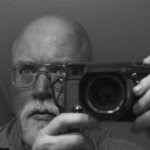Photo by Sammy Davis, Jr.
 This book is a mixed bag and I come away from it with mixed feelings. If Sammy Davis, Jr. shot as many frames as the book seems to imply, he perhaps wasn't much of a photographer as many of the images in the book are of dubious quality. However, I cannot make the mistake of comparing him to contemporaries such as HCB. He was a singer, an actor, a dancer, a muscian, and a consumate live entertainer. He seemed to take everything he did very seriously. Some of his images in this collection are rather good. Others were very badly exposed and, unfortunately, printed anyway. I think he wasn't much of an editor and, to be fair again, he didn't assemble these images. Some of the frames are delightful.
This book is a mixed bag and I come away from it with mixed feelings. If Sammy Davis, Jr. shot as many frames as the book seems to imply, he perhaps wasn't much of a photographer as many of the images in the book are of dubious quality. However, I cannot make the mistake of comparing him to contemporaries such as HCB. He was a singer, an actor, a dancer, a muscian, and a consumate live entertainer. He seemed to take everything he did very seriously. Some of his images in this collection are rather good. Others were very badly exposed and, unfortunately, printed anyway. I think he wasn't much of an editor and, to be fair again, he didn't assemble these images. Some of the frames are delightful.One thing that makes this collection interesting is the subject matter. He had access to, of course, the Rat Pack, Marilyn Monroe, Richard Burton, Liz Taylor, Jerry Lewis, Nat King Cole, and so on. Most of the images are candid. Those are pretty good, and some are actually very good. Other shots are posed with big smiling faces blasted flat with a flash bulb, harsh shadows on the wall. Some are blurred, and some are slightly out of focus. If you weed out everything that a proper editor would weed out, the book would be half its size. But some folks want to see the bad stuff because they want to see the people in the bad shots. The book isn't expensive ($50, 2/3 of that from amazon.com). For $32 books, a big book would sell better than a thin book.
Was Sammy a good photographer? I think he was a good amateur photographer. He used good equipment. Some of his shots are inspiring. The snapshots are awful, especially those with flash. I preferred the blurred motion, slightly out of focus, natural lighting shots. Probably because I shun the flash altogether, use a Rolleiflex and Nikon RF, and a lot of my shots are blurred and slightly out of focus. But I have the sense to bury the really bad ones never to be seen by others.
The narrative by author Burt Boyar is interesting and welcomed. He has spent a lot of time studying and writing about Sammy Davis, Jr., and I'm glad that he was responsible for assembling this collection. Should you buy it? Go to Barnes and Noble, get a cup of coffee, and look at it. Ultimately, it is probably a book that a serious photographer might want to check out of the local library. But I was pleasantly surprised by some of Sammy's shots here. He never did anything without trying to do it well. He was a lot better photographer than was Patton, but photography wasn't Patton's strongest suit either. I came away from this book with even fonder feelings toward Sammy than I had before. I've always liked him as a man.
Labels: Jr., Sammy Davis










